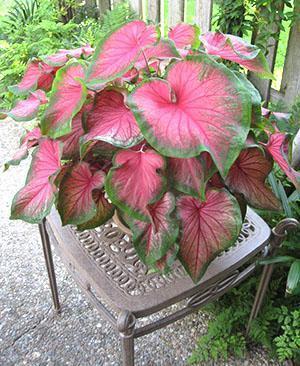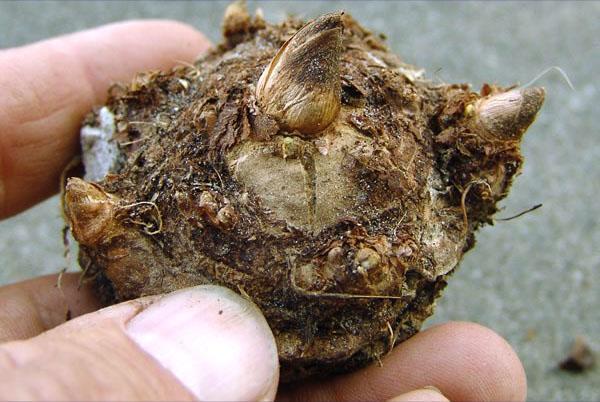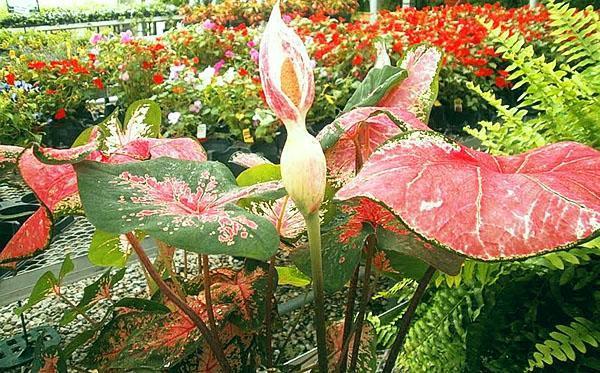What is the difference between caladium and caring for it from other indoor plants
 Ornamental foliage plants most often come from subtropical or tropical regions of the world. Caladium is a rather small but extremely striking genus from the tropical regions of the American continent, including 15 independent species.
Ornamental foliage plants most often come from subtropical or tropical regions of the world. Caladium is a rather small but extremely striking genus from the tropical regions of the American continent, including 15 independent species.
At home, perennial herbaceous plants live under the canopy of the forest, where they form dense dense clumps in comfortable conditions. A characteristic feature of the culture is large pointed-heart-shaped leaves, because of the shape, size and extraordinary colors of which the caladiums, in the photo, are popularly compared with elephant ears or angel wings. And such comparisons are well founded.
Even in wild varieties, leaf plates can reach 30–45 cm in length, and a rainbow or an artist's palette can envy the variety of shades on the leaves of caladium.
The plant does not have a regular stem. The leaves appear above the ground on long erect petioles and, gradually expanding, form dense rosettes with a diameter of half a meter.

What inexperienced growers mistake for a caladium flower is an inflorescence. Its appearance can be expected after the opening of the third or fourth sheet. The inflorescence looks like a fairly large dense ear, consisting of male and female flowers and wrapped in a pointed veil.
 In some varieties of caladium, as in the photo, it is painted in the same tones as the bright leaves. But there are varieties with white or greenish bracts. Flowering lasts no more than a few days, and a month after pollination, rounded reddish-orange berries ripen on the former ear.
In some varieties of caladium, as in the photo, it is painted in the same tones as the bright leaves. But there are varieties with white or greenish bracts. Flowering lasts no more than a few days, and a month after pollination, rounded reddish-orange berries ripen on the former ear.
Several species of this tropical plant have been used in culture. One of them is Caladium esculentum, whose starchy tubers are edible and used in food in several countries in South America..
But the whole world became famous not for edibles, but for decorative ones, as in colorful photos of caladiums. Wild plants of the species Caladium bicolor, Caladium marmoratum, Caladium picturatum and other varieties have become material for breeders, who subsequently received hybrids used today in garden and indoor floriculture.
Caring for Caladium at Home
Caladium care is influenced by the preferences prevailing in the original growing conditions, that is, in the tropics.
 As with all variegated plants, caladiums need a lot of light. And the brighter the colors on the leaves, the more sun the culture needs. But the direct rays are destructive for those accustomed to life under the crowns of plants. The best place:
As with all variegated plants, caladiums need a lot of light. And the brighter the colors on the leaves, the more sun the culture needs. But the direct rays are destructive for those accustomed to life under the crowns of plants. The best place:
- east or west windows;
- open terraces or loggias that protect foliage from the scorching light;
- tree trunks, if in summer the culture is taken out into the open air.
If southern windows are chosen for pots with a caladium flower, shading is imperative. On the north side, the color of the foliage will inevitably suffer, so in this case you will have to take care of backlight.
During the entire growing season, as well as when storing tubers during their hibernation, Caladium will be comfortable at normal room temperatures.
Bearing in mind the tropical origin of the plant, you need to know that the success of caring for caladium, as in the photo, at home largely depends on the humidity of the air. In summer, culture develops well in the fresh air, on a balcony or loggia. Together with the pot, the plants are planted in the garden or flower beds.
But when the house is excessively dry, for example, with the heating devices turned on, procedures for changing the current situation must be included in the care of the caladium.
Spraying foliage is not worth it because of possible spots on the leaf plates and discoloration, but spraying moisture over the bush will give good results.
From spring, when the first shoots appear above the ground, and until the dormant period, the caladium, in the photo, is generously watered. Signal to watering drying of the soil surface becomes. If the plant does not receive water on time, the leaves will droop and lose their attractiveness. But the extra water in the substrate is not needed either. It can cause root and tuber decay. And then there is a risk of losing the green pet.
Planting is carried out in a loose nutritious soil, which can be done by mixing in equal proportions:
- humus;
- garden land;
- peat.
You can add some sand, crushed coal and sphagnum to the resulting substrate. Before planting the tubers, the soil is sterilized, and then laid out in pots on top of a powerful drainage layer.
Containers for caladiums, as in the photo, are chosen based on the size of the tubers. For the smallest specimens, take pots with a diameter of 9–12 cm.
Adult tubers should be planted in containers with a diameter of at least 20 cm, since large leaves grow well and require a lot of soil and space for food.
Caladium care during rest
When caring for caladium at home, you need to take into account that these plants have a mandatory dormant period, which in the middle lane falls on the autumn-winter time.
 By September, to prepare the tubers for hibernation, gradually reduce the intensity of watering. After that, the wilting and falling of the foliage begins, meaning that moisture is no longer needed at all.
By September, to prepare the tubers for hibernation, gradually reduce the intensity of watering. After that, the wilting and falling of the foliage begins, meaning that moisture is no longer needed at all.
Dried caladium tubers in autumn:
- removed from the ground;
- gently clean off the remnants of the substrate and dried roots.
- examined for damage, rot, or signs of disease.
All damaged tissues are removed, and the cut sites are treated with a fungicide and, after drying, the preparation is sprinkled with crushed activated carbon.
Tubers hibernate in dry moss or vermiculite at room temperature until, in January or February, a growth bud is clearly visible at the top, ready to give life to a new rosette of leaves.